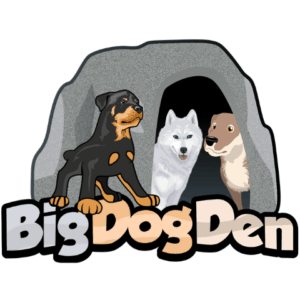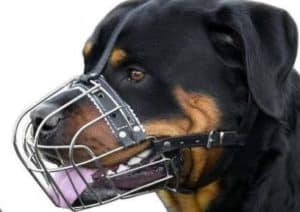I know a lot of people who’ve opted against owning a Big Dog with the reason being the dog might be “too aggressive”. However, I beg to differ in opinion. I’ve known dogs that weigh in at as much as 130 pounds (about 59 kg) and dogs that weigh in at a mere 5 pounds (a little over 2 kg). Sometimes, the latter showed themselves more aggression than the former! And so, the answer to our question…
Are big dogs REALLY more aggressive? Absolutely Not. A healthy, well-trained and well-socialized dog of a large size is no more aggressive than any other dog. In fact, the breeds that do tend toward aggression are usually very small!
But you don’t have to take my word for it, I’ve done the research to back them up, and today I’ll share the results of that research with you.
In this article, you’ll learn:
- Why Some Big Dogs Become Aggressive
- Preventing Aggression in Big Dogs Through Training
- Socializing Big Dogs to Prevent Aggression
- The Link Between Aggression in Big Dogs and Exercise
- Signs of Aggression in Big Dogs
- And So Much More!
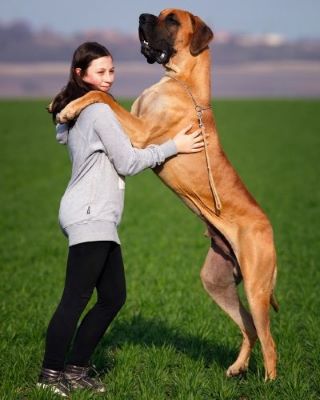
So What Can Make a Big Dog Aggressive?
The short answer to this question is a resounding “Humans!” But there’s more to it than that. We must look at the “whole picture” when regarding a Big Dog’s behavior.
Some factors that affect aggressive behavior are:
-
Temperament:
Every Big Dog is as individual as every human! Some are shy, some outgoing. Some are timid and some are bold. It’s true that every dog breed has its own temperament traits, as well, although every dog in the breed may exhibit the traits to varying degrees. Although training may not reverse or eliminate an inherent trait, it will certainly teach the Big Dog the acceptable behaviors you expect from him. There is nothing your dog wants more in this world than to please you!
-
Bad Health:
A Big Dog that is ill simply cannot respond to our commands, training, and expectations of him at full capacity. Regular veterinary care is essential from puppyhood into a Big Dog’s “senior years”! And a veterinarian isn’t the only thing that has an impact on our dog’s overall health! Proper hydration and nutrition play a role, as well as adequate exercise and the ability for a Big Dog to have a genuine bond with his human(s).
-
Pain:
If you’ve ever lived several days in a row in pain, you know it can temporarily change everything about you, even your perception. Pain is a powerful entity! A Big Dog that is in pain can even snap at his favorite human when the pain has over-powered his good behavior. This is the dog’s natural instinct for self-preservation shining through and not an indicator of his overall behavior. If you know your Big Dog is in pain, take caution when interacting with him!
-
Lack of Training:
How is it that we can take a two-year-old human from temper-tantrums and inappropriate behaviors and transform him into a socially acceptable and productive member of our society? Through training! The same applies to our Big Dog! Training begins in puppyhood and should be an ongoing and life-long endeavor. Our puppy doesn’t know he shouldn’t nip, pee on the carpet, or jump on humans until we teach him. The same applies to aggressive behaviors.
-
Lack of Socialization:
This term simply means exposing your Big Dog to other animals and other humans. The more exposure they receive, the less nervous they will become. Unsocialized dogs of any size will go into “self-preservation” mode when faced with new people or animals they are not familiar with. This nervousness and self-preservation trait can easily escalate to aggression.
-
Natural Instincts:
Even the most well-behaved Big Dog has inherent and natural instincts. Without question (no matter the size of the dog) these instincts can trigger aggression. A bitch (female dog) WILL protect her pups at any cost. Male or female, your Big Dog WILL protect their human (and perceived territory). And any dog WILL protect themselves when confronted by another aggressive dog. It’s nature, and not bad behavior, in these instances.
Take heart! Those factors have not “doomed” you to have an aggressive dog. A little further along, we’ll discover the preventative measures that can be taken as they pertain to each of the behavioral factors listed above.
Are Big Dogs More Dangerous?
All dogs harbor the potential to be dangerous! Why? Simply because they are dogs. Big Dogs’ potential to be dangerous gets more “publicity” because when things get dangerous with a Big Dog, the damage is more notable. The rule of thumb here is the more training and socialization your Big Dog has, the less he will exhibit any aggressive tendencies or behaviors.

Warning Signs of Aggression in Big Dogs
When people say, “The dog just attacked out of the blue!” they are wrong. It’s more likely the human didn’t notice the signs or didn’t recognize the sign that the dog’s agitation was escalating. According to the American Kennel Club (AKC) some of the signs that a Big Dog is agitated and might be escalating toward aggressive behavior are:
- An Intense Stare
- Ears That are Laid Flat Back (or Standing Straight Up Stiffly)
- Bared Teeth and/or a Curled Lip
- A “Guard Stance”- Head Lower than Shoulders
- Hackles are Raised- Hair on Back and Neck Stand Straight Up
Additionally, a Big Dog may also exhibit these behaviors when his aggression level is increased:
- A Low and Glutteral Growl
- Whale Eyes (The Whites of the Dog’s Eyes Will Show).
From the start, purpose yourself to learn your Big Dog’s body language. This is your first line of defense when it comes to catching aggressive behavior (and correcting it) as soon as possible.
Is Aggression in Big Dogs Preventable?
It’s good to know that aggression in Big Dogs (or any sized dog) is preventable to a large extent! Of course, the younger the dog, the more easily we can influence his behavior through overall health, proper training, frequent socialization, and by forming a strong and gentle bond with him. When you’ve addressed each of these things in a gentle and consistent manner, the risk of your Big Dog becoming aggressive is significantly reduced.
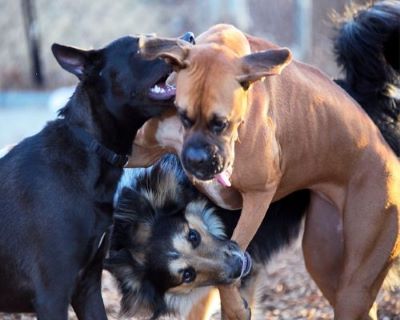
The Link Between Health and Aggression in Big Dogs
What happens to your personality when you are ill? Do you tend to be more sensitive? Do you get irritable? Do you “snap” at others without meaning to? The same things can manifest in your Big Dog when they aren’t functioning in optimum health. The difference between us and them is that we comprehend that we aren’t feeling well, and take steps to be as “civilized” as possible in our behaviors, even though it can be hard sometimes!
Our Big Dog doesn’t have the same cognitive abilities. He just knows he feels horrible, without understanding why. And an irritable Big Dog can manifest signs of aggression. That’s just a fact for any human or animal.
Socializing Your Big Dog to Prevent Aggression
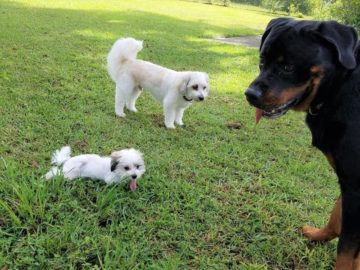
No matter the dog’s size, socialization is imperative to helping your dog be “well-rounded” in social situations. Proper socialization is even more important, though, when dealing with a Big Dog. Because he is “your baby” it’s easy to forget that some people are terrified by Big Dogs naturally (or with good reason from a bad experience in their past).
To ensure both your dog any human or animal that will come into contact with him will be more comfortable, begin exposing him to different animals and humans from a very young age. Reward his good behaviors in social situations with praises or with treats, and quickly remove you Big Dog from a situation if he manifests any signs of aggression (listed above). Use a consistent vocal command when your dog acts in an unacceptable way. Short and sweet works best. “NO!” is a perfect choice.
Exercise and Aggression in Big Dogs
In humans and in animals, exercise is an efficient way to burn off excess energy. We become restless and agitated, don’t we(?) when we’ve been “cooped up” or immobile for too long a length of time. The same applies to animals! Your Big Dog requires no less than one hour of vigorous exercise daily, and that is the bare minimum! They certainly would benefit from about triple that. “Unburned” energy will manifest as agitation, and could even lead to aggression.
Big Dogs and the Need for a Muzzle
We do not muzzle our Big Dog because he is mean… we muzzle him because he is a Big Dog! Gone are the days when a muzzle was cruel to the dog wearing it. Today’s selection of muzzles will allow dogs to breathe freely, drink water, and even eat! The Big Dog Den’s recommendation for a muzzle is a “Basket Muzzle”. But by all means, get the muzzle that best suits your dog’s needs!
Big Dog Muzzle Selection on Amazon
If you’re curious about when a muzzle is necessary or would like more detailed information about muzzling your Big Dog, you’ll learn everything you must know right here in the Big Dog Den at the other end of this link. The article uses a Rottweiler as an example, but the information pertains to ANY Big Dog!
Bonding with Your Big Dog to Prevent Aggression
All the best tricks you’ve ever seen Big Dogs do came from extensive training. Above the 5 Basic Commands (Come, Sit, Heel, Down, and Stay) we can also train them to jump hurdles, to play “Fetch” and even to dance! We can call all these learned behaviors “external”. When it comes to the “internal” behaviors like gentleness, loving-kindness, and “manners”, bonding steps in. Taking the time to form a genuine bond with our Big Dog is beneficial to humans and canine alike.
I’m so glad you dropped by the Big Dog Den Today! Your research on this important topic shows that your desire is to be a responsible Big Dog owner, and that’s the best thing you can be for your Big Dog and for every human (or animal) he will come in contact with.
*This article has been reviewed in accordance with our editorial policy.
